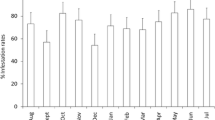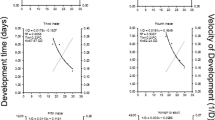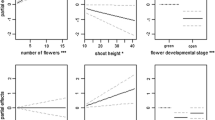Abstract
Environmental characteristics (for example, temperature, photoperiod) as seasonal cues can affect the offspring sex ratio and reproductive tactics of many hymenopteran insects. Leptocybe invasa Fisher & La Salle is the most critical invasive insect pest of Eucalyptus spp. in the world and displays thelytokous reproduction. In the current study, we studied the effects of temperature and photoperiod on offspring sex ratio and reproductive tactics in L. invasa. Results show that sex ratio (female: male) of L. invasa was under 15,25 and 35 °C with both L12: D 12 and L16: D 8, and cold and thermal acclimation were 74.5:1, 71.0:1, 59.0:0, 17.3:1, 53.0:0, 64.0:0, 47.0:1 and 56.0:0, respectively, which was highly significantly female biased and with no significant difference due to temperature or photoperiod. Offspring virgin females oviposited and induced the bump-shaped galls on plants under the same conditions as described above. Constant temperature, photoperiod and their interaction, and cold and thermal acclimation had no significant effect on the infestation rates of Eucalyptus branches induced by offspring virgin females. Thus, temperature, photoperiod and cold and thermal acclimation did not influence female- biased sex ratio and tactics with thelytokous reproduction of offspring females in L. invasa.
Similar content being viewed by others
References
Akhtar M. S., Patankar N. V. and Gaur A. (2012) Observations on the biology and male of eucalyptus gall wasp Leptocybe invasa Fisher & La Salle (Hymenoptera: Eulophidae). Indian Journal of Entomology 74, 173–175.
Bouletreau M. (1976) Influence de la photoperiode subie par les adultes sur la sex ratio de la descendance chez Pteromalus puparum (Hymenoptera; Chalcldidae). Entomologia Experimental et Applicata 19, 197–204.
Bowen W. R. and Stern V. M. (1966) Effect of temperature on the production of males and sexual mosaics in a uniparental race of Trichogramma semifumatum (Hymenoptera: Trichogrammatidae). Annals of the Entomological Society of America 59, 823–834.
Chen H. Y., Yao J. M. and Xu Z. F. (2009) First description of the male of Leptocybe invasa Fisher & La Salle (Hymenoptera: Eulophidae) from China. Journal of Environmental Entomology 31, 285–287. (in Chinese with English abstract)
Dhahri S., Ben Jamaa M. L. and Lo Verde G. (2010) First record of Leptocybe invasa and Ophelimus maskelli eucalyptus gall wasps in Tunisia. Tunisian Journal of Plant Protection 5, 231–236.
Duale A. H. (2005) Effect of temperature and relative humidity on the biology of the stem borer parasitoid Pediobius furvus (Gahan) (Hymenoptera: Eulophidae) for the management of stem borers. Environmental Entomology 34, 1–5.
Flanders S. E. (1939) Environmental control of sex in hymenopterous insects. Annals of the Entomological Society of America 32, 11–26.
He L. F., Qiu H. G., Fu W. J. and Shen B. J. (1990) Factors influencing sex ratio in Trichogramma dendrolimi (Hymenoptera: Trichogrammatidae). Natural Enemies of Insects 12, 66–70.
Hoelscher C. E. and Vinson S. B. (1971) The sex ratio of a hymenopterous parasitoid, Campoletis perdistinctus, as affected by photoperiod, mating, and temperature. Annals of the Entomological Society of America 64, 1373–1376.
Jardack T., Pintureau B. and Voegele J. (1979) Mise en evidence d’un nouvelle espece de Trichogramma (Hym.: Trichogrammatidae). Phenomine d’intersexualite’, etude enzymatique. Annales de la Societe Entomologique de France 15, 635–644.
Ji X. Y., Hua L. D., Jiang J. X., Wan N. F. and Yang J. J. (2011) The influence of temperature and photoperiod on parasitism and female ratio of Microplitis pallidipes. Chinese Journal of Applied Entomology 48, 370–374. (in Chinese with English abstract).
Kavitha Kumari N. (2009) Bioecology and management of eucalyptus gall wasp, Leptocybe invasa Fisher & La Salle (Hymenoptera: Eulophidae). MSc Thesis, University of Agricultural Sciences, Bangalore, India, 79 pp.
Kavitha Kumari N., Kulkarni H., Vastrad A. S. and Basavana Goud K. (2010) Biology of eucalyptus gall wasp, Leptocybe invasa Fisher & La Salle (Hymenoptera: Eulophidae). Karnataka Journal of Agricultural Science 23, 211–212.
King B. H. (1987) Offspring sex ratios in parasitoid wasps. The Quarterly Review of Biology 62, 367–396.
Luo J. T., Jiang J. P., Wang J. J., Chen J., Zhou Q. H. and Chen J. R. (2011) Bionomics of Leptocybe invasa in Bobai of Guangxi Zhuang Autonomous Region. Forest Pest Disease 30, 10–12. (in Chinese with English abstract).
Mendel Z., Protasov A., Fisher N. and La Salle J. (2004) Taxonomy and biology of Leptocybe invasa gen. & sp. n. (Hymenoptera: Eulophidae), an invasive gall inducer on eucalyptus. Australian Journal of Entomology 43, 101–113.
Sangtongpraow B., Charernsom K. and Siripatanadilok S. (2011) Longevity, fecundity and development time of Eucalyptus gall wasp, Leptocybe invasa Fisher & La Salle (Hymenoptera: Eulophidae) in Kanchanaburi province, Thailand. Thai Journal of Agricultural Science 44, 155–163.
Tung G.-S. and La Salle J. (2010) Pest alert—A newly discovered invasion of gall-forming wasps, Leptocybe invasa (Fisher & La Salle), on eucalyptus trees in Taiwan. Formosan Entomology 30, 241–245.
Werren J. H. and Charnov E. L. (1978) Facultative sex ratios and population dynamics. Nature 272, 349–350.
Zhang H. F., Kang W. T., Chen S. L., Tang X. H. and Lin X. Q. (2012) Study on the relationship between Eucalyptus clones and the damage degrees caused by Leptocybe invasa Fisher et La Salle. Journal of Fujian College of Forestry 32, 345–349. (in Chinese with English abstract)
Zheng X. L., Li J., Yang Z. D., Xian Z. H., Wei J. G., Lei C. L., Wang X. P. and Lu W. (2014a) A review of invasive biology, prevalence and management of Leptocybe invasa Fisher & La Salle (Hymenoptera: Eulophidae: Tetrastichinae). African Entomology 22, 68–79.
Zheng X. L., Yang Z. D., Li J., Xian Z. H., Yang J., Liu J.Y., Su S., Wang X. L. and Lu W. (2014b) Rapid identification of both sexes of Leptocybe invasa Fisher & La Salle (Hymenoptera: Eulophidae: Tetrastichinae): a morphological perspective. African Entomology 22, 643–650.
Zhu F. L., Qiu B. L. and Ren S. X. (2013) Oviposition behavior of Leptocybe invasa. Chinese Journal of Applied Entomology 50, 192–196. (in Chinese with English abstract)
Author information
Authors and Affiliations
Corresponding author
Rights and permissions
About this article
Cite this article
Zheng, XL., Lin, K., Huang, ZY. et al. Offspring sex ratio and reproductive tactics of Leptocybe invasa (Hymenoptera: Eulophidae): testing the effect of environmental characteristics. Int J Trop Insect Sci 38, 394–399 (2018). https://doi.org/10.1017/S1742758418000127
Accepted:
Published:
Issue Date:
DOI: https://doi.org/10.1017/S1742758418000127




